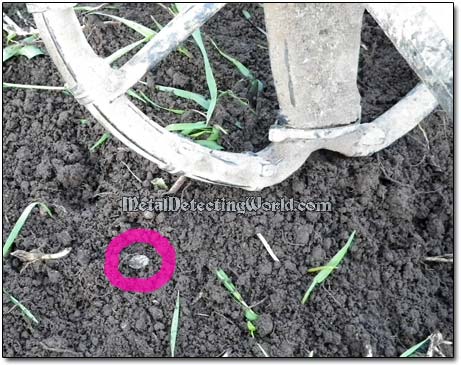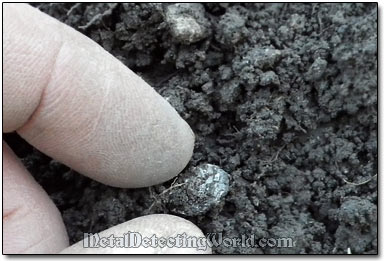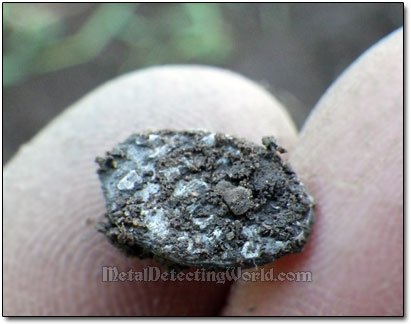Metal Detect Hammered Wire Money
Search Coil Discipline and Recovery Techniques for Single Wire Coins, page 1
Special Search Coil Discipline
Searching for hammered wire coins - wire money, requires a little more than just regular Search Coil Discipline. The wire-coin shooting is productive only when you swing a search coil no higher than 1-2 inches above the ground, keep the coil parallel to the surface all the time, and overlap each swing at least 25% (with a Double-D search coil). I usually "drag" the coil flat on the ground if its surface is free of large rocks and/or rough bumps. The search coil must be swept with low speed at the nail-littered spots: the slower, the better. Headphones MUST be used.
In any case of nail masking a wire hammered coin, it is much harder to isolate an audio response to a wire-coin than a response to a regular coin. For that, a special "search coil wiggling" technique is used: one moves the coil back and forth with quick irregular motions while turning 90° around the wire coin's signal spot. Once a coin's response is isolated, the coil is moved back an inch, the signal is rechecked, and the coin's exact location is pinpointed.
Recovery Techniques for Retrieving Tiny Hammered Coins
Since the detectable tiny hammered coins mostly are superficial targets, deep digging is not required unless you detect and need to recover the "louder" by-products of hammered coin shooting - small bronze-alloyed artifacts and thin-sectioned billon (silver/copper) coins. Depending on physical characteristics of the ground surface and soil, you may use one of the following recovery techniques:
1) Soft and dry or slightly moist ground without grass or vegetation
To retrieve a detected wire coin, you pinpoint its exact location, pick up a small amount of dirt from this spot with your gloved hand, and bring the dirt in a tightly closed fist to a search coil. To get a signal, rotate your fist in different directions while moving it in front of the coil.
Before you get a knack for retrieving such small coins, you should use a piece of ground cloth on which you spread the scanned amounts of dirt. Sometimes, even if the tiny coin is inside the dirt clod that you are clenching in your fist and moving in front of the coil, you may not get a clear and loud audio response. And if you toss this amount of dirt on the ground, the dirt-enclosed coin will "disappear" among small lumps of dirt, and you will have to repeat the process again. It is much easier and quicker to do it if the dirt is placed on the ground cloth.
NOTE: When the soil is moist, the tiny hammered coin is most likely to be encompassed in a small lump of dirt, and, therefore, be invisible.
A Partially Visible Silver Hammered Wire Coin inside a Dirt Lump
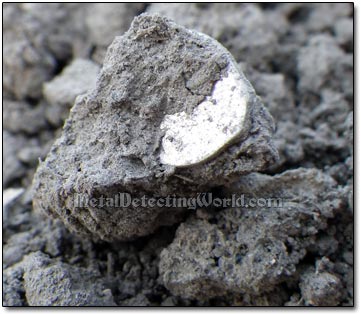
In case of losing the coin, all dirt must be spread thin and scanned again. If you do not get a signal, move the dirt around so that the sought coin would take a detectable position. If you still do not get a signal, listen for nulling of threshold which would indicate presence of small iron objects in dirt, which may mask the coin. Use All Metal mode by switching to QuickMask (with "open" screen) to retrieve the iron pieces and/or locate the coin. Do not forget to scan the hole again before covering it.
In sandy or dry soil, it will be easy to see a tiny silver coin as it will not be plastered with dirt.
Silver Wire Hammered Coin Found in Dry Ground
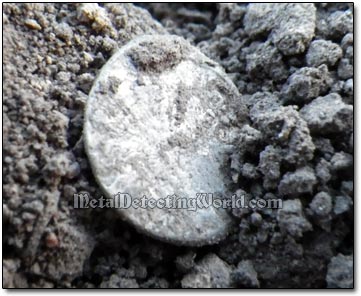
However, being not in dry soil, the coin is likely to get scratched by sand and/or small rocks if forcefully moved around along with the soil. When looking for the coin in dirt in front of you, pay close attention to all tiny objects of round and oval shapes. With time, your eyes will be trained to spot the minuscule wire hammereds among the dirt lumps, small pebbles and other debris on the ground right away.
